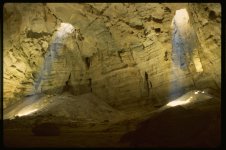I am interested in finding out more about "ascending" dissolution/erosion shafts/chimneys. To be as clear as I can, I mean those chimneys that are made by vortexes in the ceiling of a gallery by water under pressure (in the phreatic phase formation).
We're exploring a limestone cave that has many such shafts, especially in the ceiling of a main collector gallery, some as high as 40 m - a pleasure to climb artificially just to hit the ceiling closing those leads. Would like to learn more about genesis and morphological distinctive features of such chimneys.
Can you point me to research papers / books / literature about this subject? I have searched over the internet and found some results but not too many relevant ones so I guess I am not using the correct terminology. I think I have grasped the basic and general genesis mechanism so I am interested in more advanced studies/theories and detailed explanation. As you figured out, I have no geoscience studies so I would like to know the dedicated terminology used in English as well to be able to search better. Thanks in advance.
I am not interested in the particular case of cave genesis by thermal water dissolution - I know that there are theories that say that many cavities were formed by geothermal processes but I guess that is a different thing.
We're exploring a limestone cave that has many such shafts, especially in the ceiling of a main collector gallery, some as high as 40 m - a pleasure to climb artificially just to hit the ceiling closing those leads. Would like to learn more about genesis and morphological distinctive features of such chimneys.
Can you point me to research papers / books / literature about this subject? I have searched over the internet and found some results but not too many relevant ones so I guess I am not using the correct terminology. I think I have grasped the basic and general genesis mechanism so I am interested in more advanced studies/theories and detailed explanation. As you figured out, I have no geoscience studies so I would like to know the dedicated terminology used in English as well to be able to search better. Thanks in advance.
I am not interested in the particular case of cave genesis by thermal water dissolution - I know that there are theories that say that many cavities were formed by geothermal processes but I guess that is a different thing.



